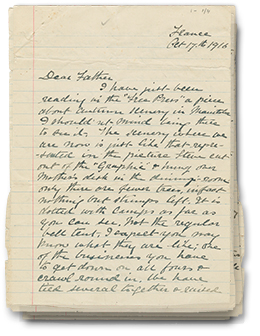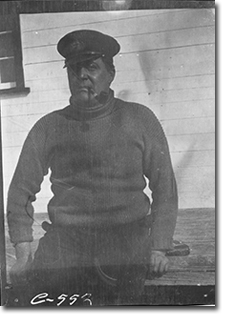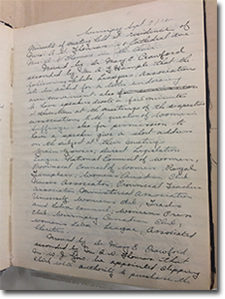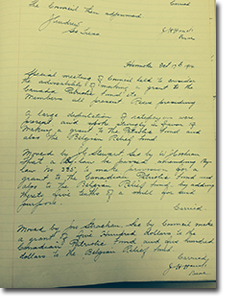The 100th anniversary of the First World War is now finished but the records will continue to be preserved at the Archives and accessible to current and future generations who want to know more about the time period. In addition, this blog will remain on our website as an additional resource.
February 2015 Posts:
- 23 February: Counting Down to the 100th Anniversary of Women’s Suffrage: the Political Equality League
- 17 February: Life – and Lice – in the Trenches
- 9 February: The S.S. Nascopie – Captain Mack
- 2 February: Patriotic Funders: A Helping Hand from the R.M. of Roblin
23 February 2015
Counting Down to the 100th Anniversary of Women’s Suffrage: the Political Equality League
In our blog post on 26 January 2015, we announced the countdown to the 100th anniversary of women’s suffrage in Manitoba which was achieved in January 1916. We will continue to feature records of individuals, organizations and the government documenting the campaign for and achievement of women’s suffrage in Manitoba.
In 1912 the Political Equality League was founded in Winnipeg to campaign for women’s suffrage in Manitoba. Prominent members included Lillian Beynon Thomas and Alfred Vernon Thomas, Dr. Mary Crawford, F. J. Dixon and Winona Dixon (nee Flett), E. Cora Hind, Nellie McClung, Francis Marion Beynon, Dr. Amelia Yeomans and Anne Anderson Perry.
The Archives of Manitoba has the League’s minute book from March 1912 to March 1914 as well as some loose meeting minutes and the League’s 1914 constitution.
In the minutes for the League’s meeting on 7 September 1912, Dr. Mary Crawford made a motion that a long list of Winnipeg and Manitoba associations be asked to endorse the newly established League and grant permission for someone from the League to come and speak about women’s suffrage at a future meeting. The list of associations includes: Grain Growers, Direct Legislation League, National Council of Women, Provincial Council of Women, Royal Templars, Women’s Canadian Club, Nurses Association, Provincial Teachers Association, Ministerial Association, University Women’s Club, Trades and Labor Council, Women’s Press Club, Winnipeg Canadian Club, Women’s Labor League, and Associated Charities.
Search Tip: Search “Political Equality League” in Keystone for more information.
Feedback (0)
E-mail us at archiveswebmaster@gov.mb.ca with a comment about this blog post. Your comments may be included on this page.
17 February 2015
Life – and Lice – in the Trenches
Jack Winter Quelch was born at Tyndall, Manitoba in 1896. His parents were Arthur and Gertrude and his siblings were Edith, Stephen and Philip. The family farmed near Birtle but the children attended school in Beulah. Jack enlisted in the Canadian Army in 1915 and served as a sniper with the 44th Battalion. The letters that he sent home to his parents and siblings document his impressions of France, Belgium and England, conditions in Europe, battles, travels while on leave, being wounded and time spent in hospital. Quelch’s letters were donated to the Archives of Manitoba in 1985.
In a letter dated 17 October 1916, Quelch described conditions in the trenches, including the continuous battle against lice:
"I should have written yesterday, but when we get back from the trenches we seem to find enough cleaning up to do to last a week what with washing, shaving & bathing & trying to rid yourself of company: this last job is mostly a waste of time as you have just as many in a day or two. We get new blankets every time we come out and they are generally full of them."
The collection of Quelch letters has been digitized and can be read online through the Archives’ Keystone database. The 17 October 1916 letter is shown here. The quote is on page 2.

enlarge (7 images)
Archives of Manitoba, Jack Winter Quelch fonds, Letter from 17 October 1916, P517/3.
Read a transcript of the letter (Letter is hidden from view. Link visually displays letter.) or download as pdf
Archives of Manitoba, Jack Winter Quelch fonds,
Letter from 17 October 1916, P517/3.
FRANCE
October 17th, 1916
Dear Father
I have just been reading in the “Free Press” a piece about autumn scenery in Manitoba. I should not mind being there to see it. The scenery where we are now is just like that represented in the picture Steve cut out of the “Graphic” & hung over Mother’s desk in the dining room. Only there are fewer trees, in fact nothing, but stumps left. It is dotted with camps as far as you can see. Not the regular bell tent, I expect you may know what they are like; one of the businesses you have to get down on all fours & crawl around in. We have tied several together & raised them up on ammunition boxes, so have a little more room. The only trouble is they sag a little & make a pocket which lets the rain in. Sometimes you get a drop on your nose just as you are going to sleep: but with our steel helmets on the top of our rifles we manage to squeeze out some of the pockets.
Well I am out of luck with this letter writing. We have to go out & build dugouts ----
----Well we are in for dinner so will polish off a few more lines before going out. I should have written yesterday, but when we get back from the trenches we seem to find enough cleaning up to do to last a week. What with washing, shaving, & bathing & trying to rid yourself of some company & this last job is mostly a waste of time as you have just as many in a day or two. We get new blankets every time we come out & they are generally full of them. I expect you will know pretty well where we are by the papers. But I think I can let you know pretty close without any harm. There was a picture of a certain church in France, in one of the illustrated papers, with a statue of the Holy Virgin on the steeple, which had been hit by a shell & not blown off, but just bent over at right angles & the saying was, when this should fall, that the war would end. Well our camp is within a mile & half of this church. It is a regular landmark.
I saw one old “tank” that had been put out of commission up near the front line, but did not have a look inside as things were a little warm just then. Hiney was sniping at us with “wissbangs”. These are three inch shells, just small ones. They call “Fritz,” “Hiney” in these parts. We were on a water carrying party at the time in a village much mentioned in the British recent advance, not a village now, but a heap of debris. There were some gruesome sights there, which showed what must have taken place. You could smell the place, half a mile away. They were mostly the [corpses] of Hineys, but there were some of our poor chaps among them. If I see this through I shall not forget that place.
There is a big mine crater; big enough to put two Birtle town Halls into: it is just about a mile from here.
This is a different place to where we were before. Hiney [put?] over “coal boxes”, “wissbangs” & shrapnel in plenty, & not just for an hour or so, but all the time, both night & day. Well this is enough of this stuff. I will tell you more if I have the good luck to see you again.
Tell Mother with many thanks that I got the cake yesterday & have now to go out to work again, so will halt for a while.
--- Well I will make another start. I have just been tramping the country to find a candle. I managed to find where I could buy one, after much trouble. Tell her I think the tallow candles will be the best to send, as they burn longer, they are things that are always handy here, & hard to get, also writing paper & addressed envelopes, as both ink & paper are scarce. Tell Mother the cake was very nice, but it is inclined to get mouldy on the way over. So I think it might be better to send more parcels like the one with the sardines in. As we can pack chocolate & tinned stuff away & take it up to the front line, where we need all we can stow away. The Oxo is “Jake” also the sardines. I usually have a few of them just before rolling in. I had a mess tin full of Oxo last night & it was all right – believe me.
The 78th are quartered about two miles from here. I have not been over to see any of the boys yet, as we are kept pretty busy & spend spare time cleaning up & all sorts of jobs.
I am on the sniping job & think it will be permanent. Round here you can see a dozen aeroplanes in the air every minute of the day & usually more.
And now I must say goodby. Give my love to all
Your [affectionate] son,
Jack
Search Tip: Read Jack Quelch’s letters online by searching “Jack Winter Quelch” in Keystone.
Feedback (0)
E-mail us at archiveswebmaster@gov.mb.ca with a comment about this blog post. Your comments may be included on this page.
9 February 2015
The S.S. Nascopie – Captain Mack
When the S.S. Nascopie was chartered as a supply vessel for the allied forces during the First World War, Captain George Edmund Mack served as its master for its first war voyage. In December 1915, Mack and the Nascopie set sail from Liverpool to Brest, France, to load supplies to be delivered at Russian ports via the White Sea. They left Brest in January 1916, carrying supplies for 12 months. Mack was a formidable man who wrote animated accounts of this journey, including a tale of a close encounter with a German submarine. Watch for this story in a future blog post.
Captain Mack was a seasoned master of HBC vessels. Born on October 15, 1887 in Norfolk, England, he entered the service of the Hudson’s Bay Company in 1910 as third officer on the S.S. Pelican. In 1912, Mack was Nascopie’s second officer on its maiden voyage into the Eastern Arctic. He continued to work aboard the Nascopie until 1920, when illness kept him on land. He was the HBC’s superintendent of Bay Transport from 1920 until his retirement in 1928.
Mack’s wartime service did not end after his Atlantic voyages aboard the Nascopie. During the Second World War, he served with the Royal Naval Reserve as a lieutenant commander. He died on November 18, 1941.

Hudson’s Bay Company Archives, Archives of Manitoba,
“Capt. G.E. Mack of ‘Nascopie’ at Wakeham Bay 1916,”
James Cantley fonds, HBCA 1987/257/N552.
See previous posts about the Nascopie from 25 August 2014 and 12 January 2015.
Search Tip: Visit the Archives to explore records about Captain Mack and the Nascopie.
Feedback (0)
E-mail us at archiveswebmaster@gov.mb.ca with a comment about this blog post. Your comments may be included on this page.
2 February 2015
Patriotic Funders: A Helping Hand from the R.M. of Roblin
Following the declaration of war in August 1914, Manitoba’s rural municipalities were rallying to the call of “country and empire”.
On October 17, 1914 the R.M. of Roblin convened a special meeting of council to “consider the advisability of making a grant” to both the Canada Patriotic and Belgian Relief Funds. These funds were created to support Canadian soldiers, their families, and other people affected by the war in Europe, including private individuals and public organizations.
The RM’s council minutes for October 17 show that the motion to grant the relief funds was supported by a large number of Roblin’s taxpaying citizens and was carried by the town’s council, who moved to endow each fund with $500.00 from its tax revenues that year.
Search Tip: To learn more about the records of the RM of Roblin, search “Rural Municipality of Roblin minutes” in Keystone.
Feedback (0)
E-mail us at archiveswebmaster@gov.mb.ca with a comment about this blog post. Your comments may be included on this page.





